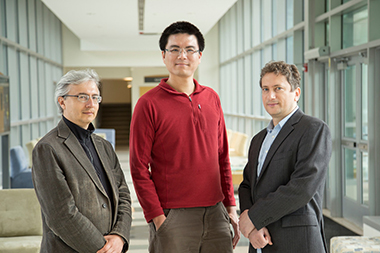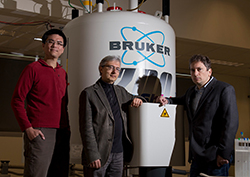Chemists Team Up to Visualize RNA-Protein Interactions
 |
|
Alan Chen (middle), Maksim Royzen (right) and Alex Shekhtman (left) have teamed up on a project to visualize RNA-protein interactions.
(Photo by Carlo de Jesus)
|
ALBANY, N.Y. (May 11, 2017) –RNA and protein molecules serve as workhorses inside of all cellular organisms. Both play important roles in ensuring our cells function properly and are essential to human life.
UAlbany chemists Alan Chen, Maksim Royzen and Alex Shekhtman are teaming up to better understand how the two interact.
Working with The RNA Institute, Chen, Royzen and Shekhtman have combined their labs on a collaborative project aimed at visualizing RNA-protein interactions inside live human cells by using multi-dimensional NMR (nuclear magnetic resonance spectroscopy) techniques.
“RNA-binding proteins are associated with various infectious and genetic human diseases,” Royzen said. “We want to be able to understand this interaction and disrupt it when necessary. Our project is the first step to creating small molecule drugs that can create that disruption.”
As a model, the three chemists have chosen a protein expressed by the HIV-1 virus, called NCp7. This protein is involved in the packaging of viral RNA into viral particles. They’re also using a short RNA strand that mimics viral RNA.
 |
|
The RNA Institute's NMR facility (pictured above) is one of only a few labs in the world that can conduct experiments on live cells. (Photo by Carlo de Jesus)
|
Each of the chemists brings their own expertise to the project: Royzen’s lab, led by graduate student Leah Seebald and undergraduate student Anastasia Glazunova, is labeling the protein and RNA samples. Shekhtman’s lab, led by graduate student Christopher DeMott, is leading the NMR experiments. Chen’s lab, along with Srivathsan Ranganathan of The RNA Institute, are handling the visualization/computational component.
“Modern science proclaims that seeing is believing,” Chen said. “Even though we have yet to successfully achieve RNA-protein visualization inside live cells, our project is describing the tools and methods to achieve this in the near future. We are excited about the possibilities.”
This is the first collaboration between the three labs. They’ve already published papers in the Journal of Inorganic Biochemistry and Inorganic Chemistry. Several other manuscripts are in progress.
The project is funded by the National Institutes of Health through Shekhtman’s lab and the National Science Foundation through Chen’s lab. UAlbany start-up funds are also providing funding to Royzen’s and Chen’s labs.
“We are grateful to UAlbany and The RNA Institute for committing significant resources to each of our research labs,” Shekhtman said. “We have state of the art NMR facility that allows us to collect data from live cells. We also have top-notch mass spectrometry instruments that allow characterization of RNA and proteins. Only a few labs in the world can conduct in-cell NMR experiments on live cells. This collaboration is truly unique.”
The RNA Institute fosters a collaborative environment among faculty members across disciplines, such as biological sciences, chemistry, public health, bioinformatics and nanosciences. Its researchers are developing RNA tools and technologies to address challenging human health problems.
Since its inception in 2009, federal, state and private investments have resulted in a significant expansion of faculty, research staff, labs and instrumentation, generating increased training and employment for graduate students and post-doctoral workers.
You can learn more about UAlbany’s Department of Chemistry here. Also view University faculty expert pages for Chen, Royzen and Shekhtman.
![]() For more news, subscribe to UAlbany's RSS headline feeds
For more news, subscribe to UAlbany's RSS headline feeds
A comprehensive public research university, the University at Albany-SUNY offers more than 120 undergraduate majors and minors and 125 master's, doctoral and graduate certificate programs. UAlbany is a leader among all New York State colleges and universities in such diverse fields as atmospheric and environmental sciences, business, education, public health,health sciences, criminal justice, emergency preparedness, engineering and applied sciences, informatics, public administration, social welfare and sociology, taught by an extensive roster of faculty experts. It also offers expanded academic and research opportunities for students through an affiliation with Albany Law School. With a curriculum enhanced by 600 study-abroad opportunities, UAlbany launches great careers.


